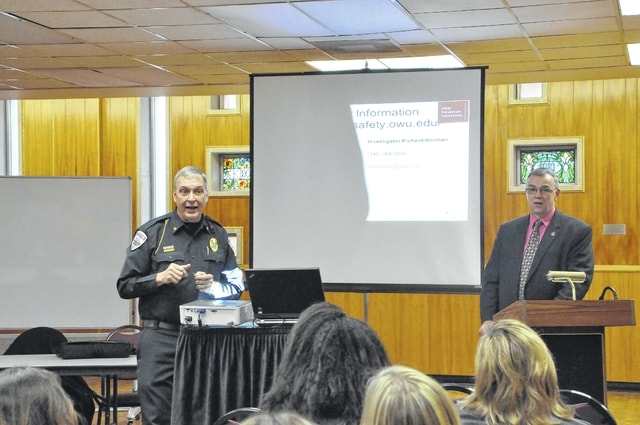
Ohio Wesleyan University does not have an armed police department to handle a mass casualty incident like the one that took place at The Ohio State University two weeks ago.
“We have a Department of Public Safety, which is overseen by a commissioned police officer, but OWU public safety officers are not armed,” said Cole Hatcher, director of Media and Community Relations. “We rely on the Delaware Police Department, and other forces as deemed appropriate by the Police Department, to respond to a volatile mass-injury situation such as OSU experienced.”
“Delaware is the primary law enforcement agency for the campus,” said Captain Adam Moore, Delaware City police. “Many of the things we saw at OSU and we heard and talked about, we’ve been engaged in that same training for the better part of 8-to-10 years.”
Moore said the shift in how active aggressors are handled started with Columbine High School in Colorado in 1999. Identify the threat, neutralize the threat as quickly as possible and then assist the injured, he said.
Moore said public safety and law enforcement agencies have a very cooperative relationship within Delaware County.
“We routinely train side-by-side with the Sheriff’s Department, Genoa Township, City of Westerville. We have a multi-agency tactical team that would respond,” Moore said.
“If a large-scale event were to occur anywhere in Delaware County, but specifically in Delaware City, we would need some help. The key points are the relationships we’ve built. You want to have those relationships ahead of a problem.”
Moore said there’s a benefit to having training. He used the analogy of an elementary school’s fire-drills as an example. When the alarm goes, students know to get in line and follow the teacher to the nearest exit, he said.
“There hasn’t been a public school child killed in a fire in 50 years,” Moore said.
Moore said there is the possibility that students now entering college may have had some training in high school or junior high school of how to handle a dangerous situation.
Some of the steps taken in the last few years in building those relationships include moving to a county-wide communication center.
Robert Wood, director of the Department of Public Safety at Ohio Wesleyan University, said when the twin towers were attacked in New York on 9/11, the biggest problem was the inability for interdepartmental communication.
“That’s a really big key in any scenario,” Wood said. “We’re really fortunate in those terms that we can get everybody on the same frequency.”
Moore said years ago Delaware County put all communications for the different departments in the county on the same communication system.
“A couple of years ago the university came onto the system,” Moore said. “Public safety officers are able to talk directly to Delaware police or fire.”
Moore said it saves time by not having to relay messages between departments.
“There’s no middleman,” Moore said. “Our response time to the university is minutes, but it shaves a lot of time off.”
Hatcher said the university uses a notification system much like the one used at OSU to alert students and staff to a possible threat on the campus.
“We test the system once each semester, with each test preceded and followed by calls for people to update their enrollment information if needed,” he said.
Dwayne Todd, vice president of Student Engagement and Success, said the university has an enrollment of 1600 students. “With being a small community, faculty and students build relationships,” Todd said. “You never know what you’ve stopped because of relationships.”
Wood said a janitor had once found a piece of paper with a drawing of the campus on it. Where Korn Hall stood someone had marked a red X and wrote “bomb here.”
“Twenty years ago you could say stupid kids,” Wood said. “You can’t do that now. You can’t treat everything like it’s a disaster, but you can’t let everything go either.”
Wood said that his public safety officers are trained in advanced first-aid and they carry a first-aid kit and automated external defibrillators (AEDs) in the cars.


